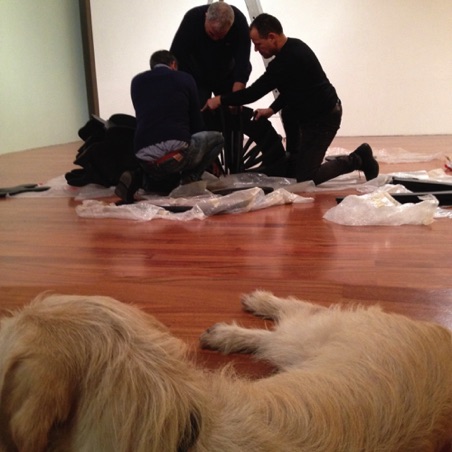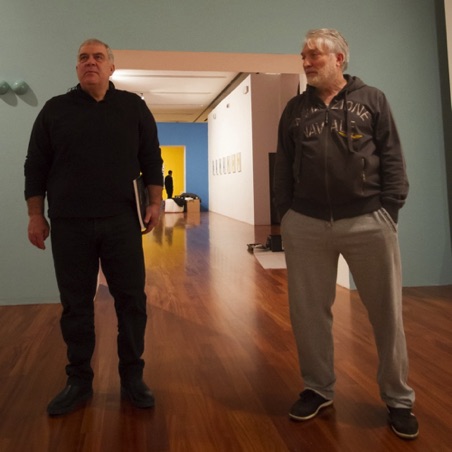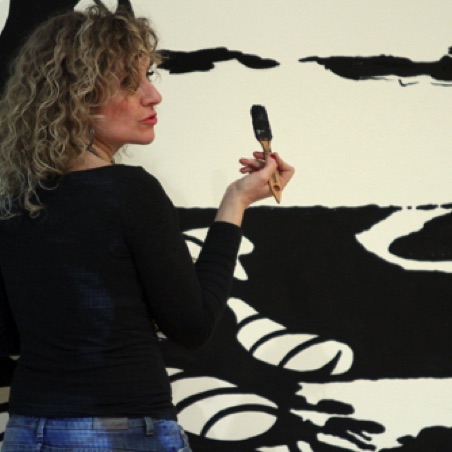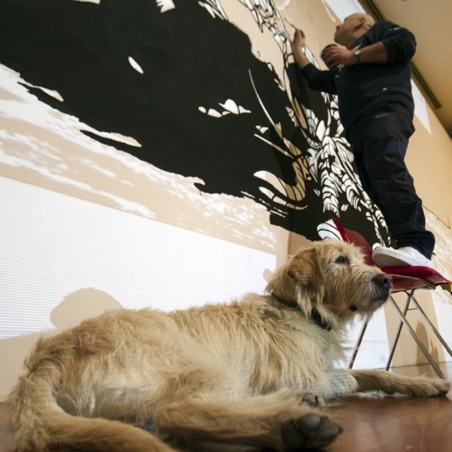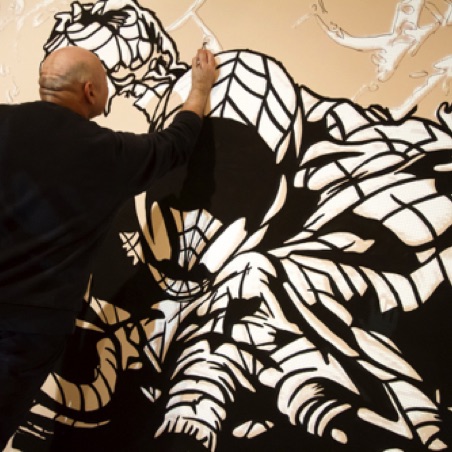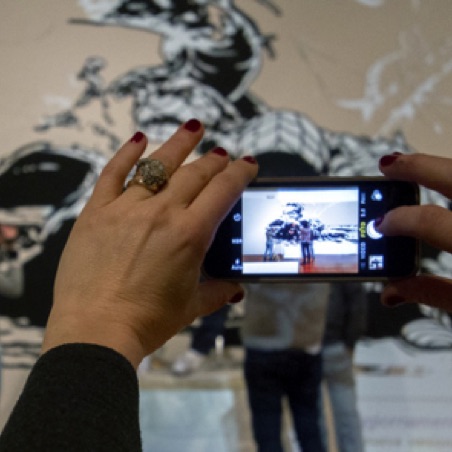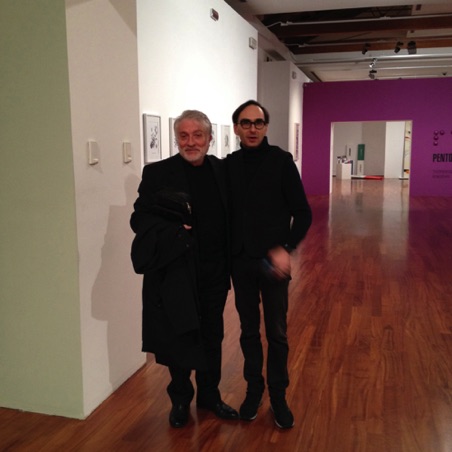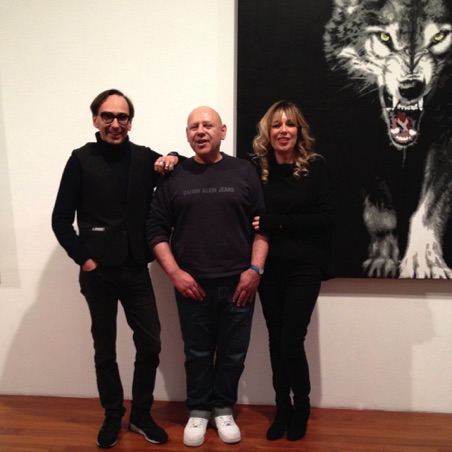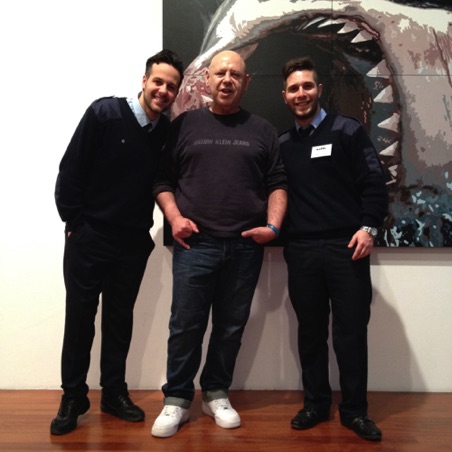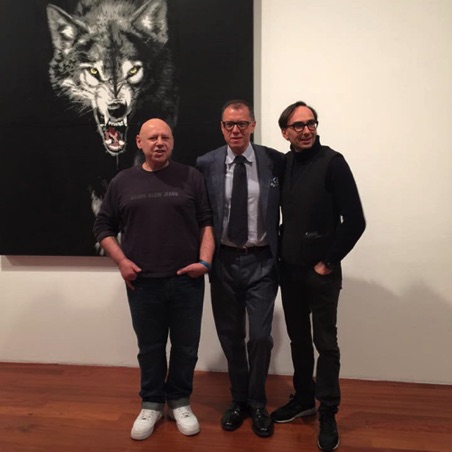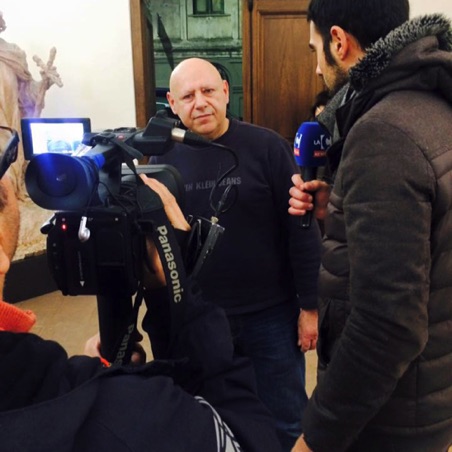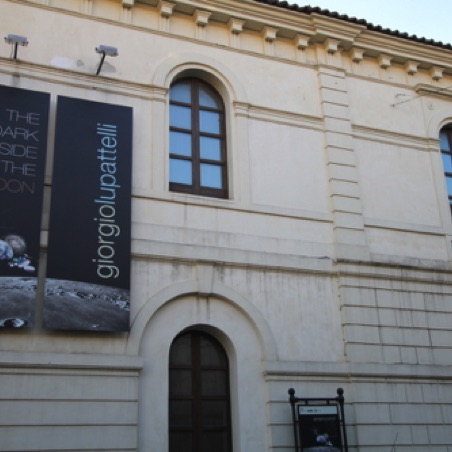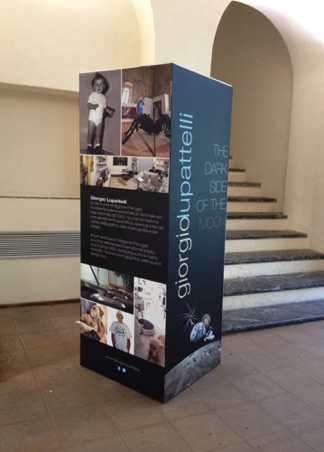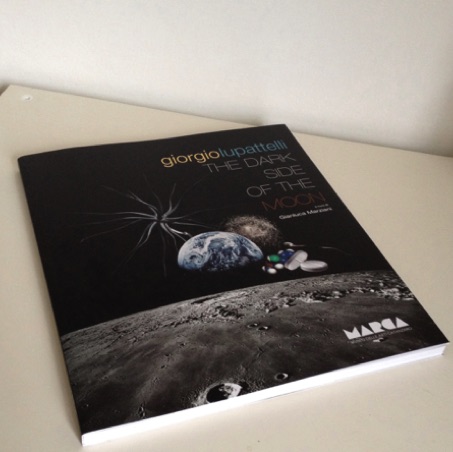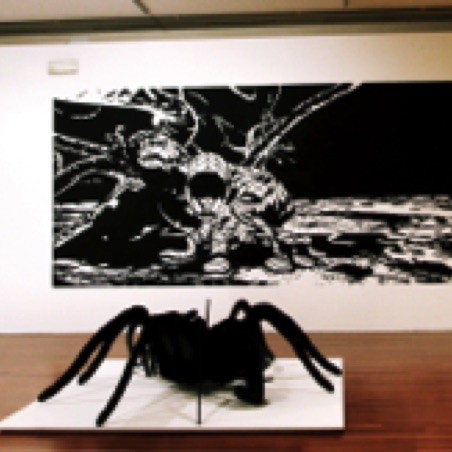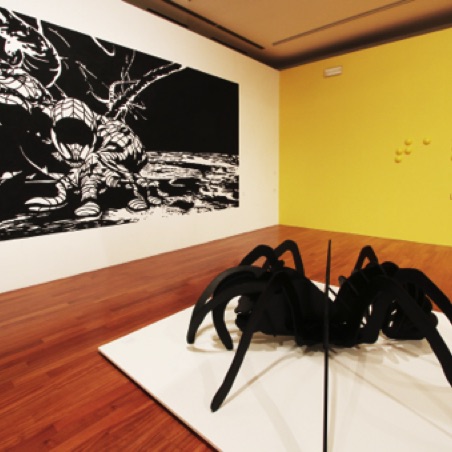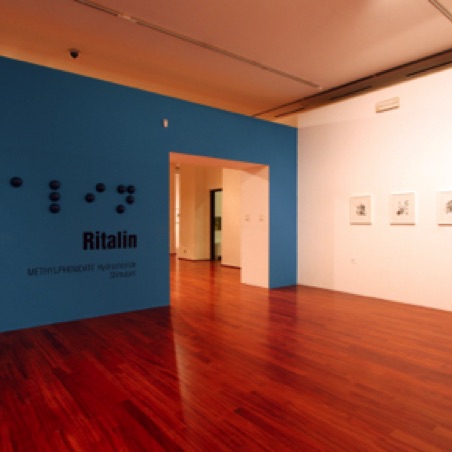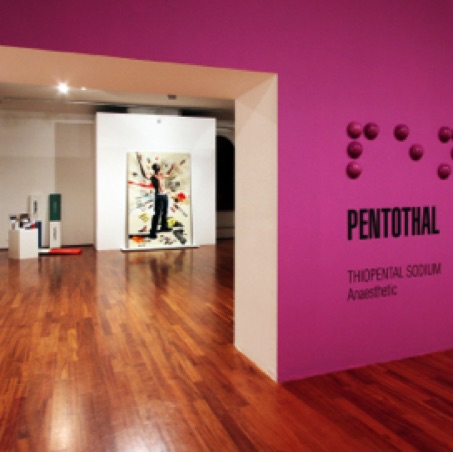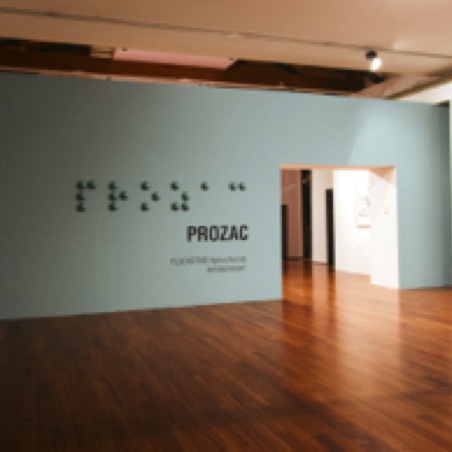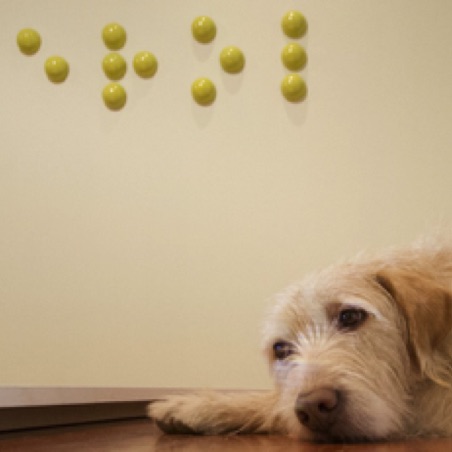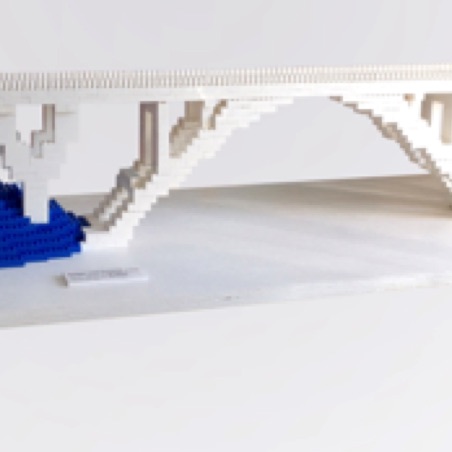giorgiolupattelli
THE DARK SIDE OF THE MOON
2016. MARCA Museo delle Arti (CATANZARO)
IL MONTAGGIO
clicca sulle immagini
L'INAUGURAZIONE
clicca sulle immagini
LA MOSTRA
clicca sulle immagini
IL PONTE
clicca sulle immagini
THE DARK OR BRIGHT SIDE ?
Gianluca Marziani
Di nuovo assieme per un viaggio espositivo, stavolta in uno dei migliori musei italiani per l’arte contemporanea. Conosco Giorgio Lupattelli da una ventina d’anni e un dettaglio mi ha sempre colpito: la precisione straordinaria con cui costruisce i progetti rispetto allo spazio indicato, un disegno digitale in scala (rendering) che veste gli ambienti con aderenza architettonica e filologia concettuale. Qualcuno potrebbe dire: quale sarebbe la novità rispetto al professionismo dietro ogni bravo artista? Ebbene, progettare in modo “sartoriale” una mostra è un dato necessario solo per alcuni, nel senso che pochi definiscono gli antefatti con siffatta minuzia, per molti i muri restano pareti passive che accolgono e non spazi inclusivi che s’integrano. Rilevarlo non è un sofisma ma un passaggio linguistico in cui la pittura rompe la sua natura statica, offrendo alla tela una via plastica, un tenore olistico svincolato dagli schemi che il mercato e i trend impongono. Da qui una dicitura per tracciare un codice linguistico: pittura volumetrica dal corpo liquido, elastica nel modo di condizionare la forma del quadro e mai viceversa. Non esistono formati predefiniti che Lupattelli adatti alle sue immagini; al contrario, sono le attitudini iconiche e i vincoli spaziali a elaborare le anomalie dei telai, l’espandersi sui muri, l’aprirsi al rilievo scultoreo. L’opera ragiona con l’elasticità aerobica di un polmone mediatico, in espansione e contrazione circolare a seconda dei profili specifici, delle chiavi semantiche, dei valori sensoriali di un messaggio. Entrando nel libro e poi nelle sale del museo vi troverete in un’impaginazione abitabile, dove il catalogo si trasforma in un edificio da attraversare e il museo in un libro a tre dimensioni. Reimpaginare il mondo, potremmo aggiungere, dove l’artista seleziona immagini con la caratura universaledegli immaginari condivisi.
E allora benvenuti nel libro, sorta di guida visuale su alcune realtà ambigue e proteiformi, una mappatura open source che ricorda Linux, il sistema operativo con l’etica del free software. Sfogliando il volume dovreste intuire la somiglianza a un sito web e il suo rimando visivo al tenore abitabile della mostra. Catalogo e allestimento sono come finestre che si aprono e chiudono sul monitor, schermate ad ingombro variabile per creare relazioni connettive tra visibile e intuibile. Sarete voi, con logica linuxiana, a plasmare una versione sequenziale e prioritaria, rafforzando così la relazione tra pagina cartacea e parete espositiva. In fondo, l’arte recente ribadisce quanto siano parziali le regole storiche del museo statico. Esiste ormai una generazione digitale che inverte i fattori spaziali, sconvolge le metriche narrative, ripensa i sistemi d’esposizione. Il taglio di Lucio Fontana è stato l’inizio di uno spazialismo che si sta amplificando sulle pareti. Se ieri il muro bianco incorniciava gli andamenti lineari di una mostra, oggi l’alto diventa basso, il corto si allunga, i centri si moltiplicano, le ottiche si allargano in una miriade di nuove posizioni. Lo spazio d’allestimento diviene attivo e prodromico, geografia d’intuizioni versatili che crea innovativi legami tra carta e luoghi. Ecco, aggiungerei che il catalogo somiglia a una mappa di antica memoria, sintesi topografica per rappresentare un territorio, in tal caso quel luogo speciale tra ideazione e forma, contenuto primario e derivato, scena e scenario.
Per definire un corrispettivo estetico del suo modus teorico, Lupattelli si basa su un codice flat, capace di simulare le trame elettroniche nel costrutto manuale del lavoro. Diciamo che l’artista rompe una certa tradizione italiana del “sospetto mediatico”, quella in cui la “vera” pittura doveva sporcarsi, analizzare se stessa, diramare i temi canonici, offrire il destro alla filologia del percorso storico. I codici mediali non sono mai stati nelle grazie di critici e storici che hanno redatto la manualistica e formato un gusto riscontrabile. Rare eccezioni hanno prodotto una faglia sistemica, Domenico Gnoli o Gino De Dominicis per dirne qualcuno ma siamo nei margini delle anomalie. Gli Anni Sessanta, certo, stavano formando un gusto pop dal sapore anglosassone e dal cuore capitolino, finché arrivò la scia materica dei concettualismi “poveri” e si ampliò l’orientamento del gusto. Lupattelli appartiene a quella generazione formatasi durante la Transavanguardia ma che non si riconosceva nel citazionismo selvaggio e allegorico. Il nostro è cresciuto nel periodo del primitivismo digitale, tra coloro che hanno seguito la pubertà di una biologia elettronica. Un modello che colpì Lupattelli da subito, così da catapultarlo nel vortice mediatico della realtà globale, nei processi di selezione e sintesi che il flusso digitale produce. Capirete che le radici conducono alla figurazione di taglio inglese o americano, Andy Warhol, Ed Ruscha o Richard Hamilton per capirci ma anche e soprattutto gli italiani, Franco Angeli e Tano Festa su tutti, con la loro registrazione sintetica del quotidiano, il loro gancio poetico ai feticci del presente, la loro visione del lato oscuro dietro i simboli popolari.
Lupattelli, osservando le azioni quotidiane nei media globali, sceglie le sole informazioni che lo colpiscono e lo conducono alla sintesi del quadro. Ogni opera prevede una lenta asciugatura tematica, una ricerca d’impatto in cui la selezione corrisponde al valore sociale della notizia. Non è semplice come azione linguistica, si può cadere nella retorica da poster o nei cascami di un pop datato. L’altro rischio è la copia passiva, tipico di opere che non interpretano ma forniscono uno specchio del vero, senza filtri e contaminazioni. Lupattelli, di contro, intuisce le germinazioni di una notizia, l’ampiezza d’urto sociale, la profondità del condizionamento generato. Merito di una veggenza che orchestra il caos, come accade quando l’arte coglie l’icona densa ma non inflazionabile. Un processo alchemico in cui le immagini plasmate condensano un singolo immaginario, un archetipo liquido che rispecchi l’anima multiforme dell’evo tecnologico.
Chi altri se non Lupattelli per attraversare il tema spaziale con le sue ragioni e i suoi codici estetici? La sua è una partenza ideale e reale, sul filo astronomico di astronavi e tute con casco, tra utopie della scoperta e ingresso nel mistero assoluto. La conquista dello spazio come accesso al dubbio, alle ambivalenze attorno a noi, alle ambiguità che ogni grosso interrogativo ci pone. Volare lontano con lo sguardo pittorico per creare una conseguente endoscopia visiva, così da afferrare le distanze dentro le vicinanze, i punti oscuri dentro le superfici chiare, le pulsazioni intime dentro i corpi mediatici.
Dallo spazio al corpo umano, dal macro al micro con fluida continuità narrativa. Bravo l’artista a dare uniformità, sia visiva che concettuale, ai passaggi tra piattaforme tematiche. Dal buio cosmico alla luce attorno ai volti del culto mediatico, attorno agli animali delle fobie diffuse, attorno ai medicinali che raccontano le derive, i misticismi e il cortocircuito di una nuova umanità contemporanea. La Biologia è il clima condiviso che unifica i piani tematici di Lupattelli, una matrice generativa che cuce le differenze sotto l’evidenza di un neoumanesimo tecnologico. Pensiamo a Kurt Vonnegut, James G. Ballard, Philip K. Dick e, di recente, Chuck Palahniuk e David Foster Wallace: romanzieri visionari tra dilatazione del presente e intuizione del prossimo futuro, tutti scrittori fortemente biologici, nel senso più complesso del termine, endoscopici nel capire il legame tra corpo e merci, cervello e schemi sociali, desiderio e feticci. Sento una comunanza battesimale tra Lupattelli e quella letteratura di riferimento, come se la sua attitudine narrativa combaciasse con una trama sottotraccia, un plot che rende plausibile la veggenza pittorica con cui scandaglia corpi, oggetti e universi.
Alcuni famosi medicinali prendono il centro della scena. Si chiamano Ritalin, Adderall, Aspirin, Demerol, Effexor, Paxil, Pentothal, Propofol, Prozac, Tavor, Valium, Vicodin… vere superstar farmaceutiche che potenziano, controllano, riparano, alterano o integrano la creatività, il talento, gli eccessi, la visione. Sono loro i protagonisti chimici dell’era mediatica, medicinali dal risvolto ambiguo che raccontano le derive del presente con attinenza e rigore etico. Lupattelli li analizza come soggetti attivi di una partnership sociale ad alta invasività, non limitandosi a ingrandire (chiaro gesto di radice pop) ma giocando col volume scultoreo, la scrittura Braille, il gulliverismo dei pattern cromatici. E’ un cortocircuito semantico che amplia le radici generative, confermando la dimensione liquida di ogni opera, al punto da connetterla ai volti da star system, ai personaggi iconici che stimolano ulteriori passaggi nel fruitore, aprendo altre vie alla lettura complessa dell’immagine.
Quei medicinali, un po’ come i barattoli da supermarket firmati Warhol, incarnano la complessa ambiguità del presente. Sono il viatico per una cura ma anche per un facile abuso tossico: in un mondo come il nostro escono dal contesto farmaceutico ed entrano nel vizio di alcuni, deragliano dalla terapia alla fantasia, dalla cura alla panacea, dall’ordinario all’eccesso. In realtà contengono il seme del narcisismo contemporaneo, quindi gli estremi del presente inquieto, al punto da attraversare le principali fobie e le mille paure individuali, mescolando benefici e delirio, bellezza e crudeltà, estasi e abbandono.
Lupattelli ha attraversato personalmente la malattia, il ricovero, la cura coi suoi effetti complessi… conosce bene il percorso nel dolore fisico e mentale, al punto da non rimuoverlo ma integrarlo nel suo sistema narrativo… ABVD è un passaggio radiografico che si contrae sull’io narrante, quasi ad allontanare l’occhio mediatico dal baluginio mondiale, portando lo sguardo sul ritratto intimo e frammentario, sull’effetto di ribadita normalità che non ci fa soccombere davanti al virtuale elettronico.
Il motto sembra uno per tutti: plasmarsi sul reale senza perdere coscienza dell’umano.
Le fobie sono il tema portante di questa società ad alto potenziale tossico. Paure di varia origine che s’insinuano nella nostra mente, nei meccanismi relazionali, nei modelli di riferimento falsato. Nella fobia Lupattelli coglie il valore drammaturgico del nuovo millennio, captando il lato oscuro dietro la bellezza e il baluginio del presente. Il punto di svolta riguarda l’approccio cromatico del racconto visivo, quella capacità di agitare bene la superficie e rendere attrattivo qualsiasi contesto di provenienza, così da sviluppare empatia col fruitore attento. L’artista manovra un meccanismo a calamita delle opere, capace di coinvolgerti nel primo stadio che è ordinato, pulitissimo, accessibile.
Lì sotto fa agitare il magma bollente che le vesti nascondono, crescere l’inquietudine delle conseguenze, il terrore della faglia sistemica. L’intera mostra è un lungometraggio installativo dentro i grandi temi morali, dentro il rapporto tra pregiudizio e giudizio, dentro la complessità che ogni apparenza riveste. L’arte di Lupattelli contiene un valore etico che trasforma l’estetica in un linguaggio liquido, plasmabile sulle misure degli spazi. Un alfabeto planetario che diviene grammatica e definisce la referenzialità di un mondo. In questo caso, il mondo di Giorgio Lupattelli.
Chiudiamo con quattro animali di pura potenza, quattro musi per altrettante espressioni che incarnano il seme primordiale delle fobie ancestrali. Qui l’autore sceglie la natura bestiale e gioca con la compressione del gesto catartico. Ci mette davanti alla paura liscia, la più istintuale ma anche la più sana, la meno filtrata e condizionabile. La pittura rimane quella di sempre, coerente a se stessa, puro codice flat che asciuga l’immagine generativa e coglie l’essenza metaforica del ritratto. Uno stile che non è fotografico o iperrealista, sia chiaro; l’estetica deriva dai software di modifica fotografica, quindi da un immaginario metabolico in cui l’artista altera i codici del realismo e agisce con mimesi elettronica, trovando un risultato di chiara lettura e facile empatia, in perfetta sintonia con la natura relazionale del Pop.
Together again for a trip that is an exhibition, this time in one of the best Italian museums for contemporary art. I have known Georgio Lupattelli for twenty years and the thing that has always struck me is the extraordinary precision with which he builds the projects in accordance with the indicated space, a rendering that recreates these spaces with an architectural adherence and a conceptual philology. Someone might say: if we consider the professionalism behind every good artist, where is the originality here? Well, designing an exhibition in a sartorial way is necessary only for some people, in the sense that only few people define the background with so many details: in fact for many of them walls remain passive walls that welcome and not inclusive spaces that are integrated. Noticing it, it is not a sophistry but a linguistic passage in which painting breaks its static nature, offering the canvas a plastic way, a holistic content free from the patterns and trends that the market dictate. Born of it a statement that draws to a linguistic code: a volumetric painting with a fluid body and an elastic painting that is able to influence the shape of the picture. There are no predefined formats that Lupattelli adapts to his images; on the contrary, the iconic attitudes and the spatial constraints develop abnormalities of the frames, the spread on the walls, the opening to the sculptural relief. The work reasons with the aerobic elasticity of a ‘media-lung’, that expands and contracts itself in a circular way depending on the specific profiles, the semantics of the keys, the sensory values of a message. When you enter the book and then the museum you will find yourself in an inhabitable layout area, where the catalog is transformed into a building and the museum into a three dimensions book. Repaginating the world, we might add, where the artist selects images with the universal caliber of the shared imaginaries.
Then welcome to the book, a sort of visual guide on some ambiguous and protean realities, an open source mapping that reminds Linux, the operating system with the ethics of free software. The book has a similarity to a web site and a visual reference to the content of the exhibition space. Catalog and equipment are like windows that open and close on the monitor screens to create connective relationships between the visible and understandable. Using the logic of Linux, you will shape a sequential and priority version, strengthening in this way the relationship between the paper page and the wall of the exhibition. After all, the contemporary art shows the insufficiency of the historical rules of the static museum. Now there is a digital generation that inverts the spatial factors, upsets the narrative metrics, recreates the systems inside the exhibition. The cut of Lucio Fontana was the beginning of a spatialism that is amplifying itself on the walls. Yesterday the white wall framed the linear trends of an exhibition, today the high becomes low, the short stretches, the centers multiply, optics widen in a multitude of new positions. The space of the equipment becomes active, a geography of versatile insights that create innovative links between paper and places. So, I would add that the catalog is like a map of ancient memory, a topographical synthesis to represent a territory, in this case that special place between conception and form, primary and derived content, scene and scenery.
To find an aesthetic equivalent of his theoretical philosophy, we could say that Lupattelli works on a flat code, that is able to simulate the electronic textures in the manual labor work. Let’s say that the artist breaks down a certain Italian tradition of the “media concerns”, where the “real” painting had to be dirty, analyze itself, issue the canonical themes, promote the philology of the historical path. The media codes were not appreciated by the critics and historians who have written manuals and formed a noticeable taste. Some exceptions have produced a little opening in this system: Domenico Gnoli or Gino De Dominicis to name a few, but they were almost considered anomalies. The Sixties, of course, were forming a pop taste with Anglo-Saxon flavour and Capitoline heart, until it came the trail linked to the”poor” conceptualisms and the orientation of taste was expanded. Lupattelli belongs to that generation formed during the Transavangarte but he did not appreciate the wild and allegorical quotationism. He grew up in the period of digital primitivism, among those who followed the puberty of an electronic biology. Lupattelli was immediately struck by that model and so he was thrown into the media circus of the global reality in the processes of selection and synthesis that the digital stream produces. You will understand that the roots lead to the English or American cutting figuration: Andy Warhol, Ed Ruscha or Richard Hamilton but also the Italian artists Franco Angeli and Tano Festa above all, with their synthetic recording of everyday life, their poetic link with the fetishes of our time, their vision of the dark side behind the popular symbols.
Lupattelli, observing the daily actions in the global media, chooses only the information that strike him and lead him to the synthesis of the painting. Each work provides a slow thematic drying, an important research in which the selection coincide with the social value of the news. Lupattelli, observing the daily actions in the global media, chooses only the information that hit him and lead him to the synthesis of the framework. Each work provides a slow drying thematic research impact in which the selection coincides with the social value of the news. This language action is not simple, because you may fall into the rhetoric of posters or of an old-fashioned pop. The other possible risk is the passive imitation, typical of works that do not interpret but provide an unfiltered mirror of the real. On the contrary Lupattelli, understands the germinations of a story, the magnitude of a social impact, the depth of the generated conditioning. He operates like a clairvoyant who orchestrates the chaos, as it happens when art captures the dense but not common icon. An alchemical process in which the shaped images condense a single imaginary, a liquid archetype that reflects the multifaceted soul of the technological times.
Lupattelli is able to cross the space theme with its reasons and its aesthetic codes. His departure is ideal and real at the same time, on the astronomical edge of spacecraft and spacesuits with helmet, between utopias of discovery and entrance into the absolute mystery. The conquest of the space as access to doubt, to the ambiguities around us, to the ambiguities that every big question poses. Flying away with the pictorial look to create a subsequent visual endoscopy, so to grasp the distances inside the vicinities, the obscure points inside the bright surfaces, the intimate pulsations inside the media bodies.
From outer space to the human body, from macro to micro with fluid narrative continuity. The artist is able to give both a visual and a conceptual uniformity to the passages between thematic platforms. From the cosmic dark to light, around the faces of the media cult, around the animals with phobias, around medicines that tell the miseries, the mysticisms and the short circuit of a new contemporary humanity. Biology is the shared climate that unifies the thematic plans of Lupattelli, a generative matrix stitching differences in the evidence of a technological neo-humanism. Let’s think of Kurt Vonnegut, James G. Ballard, Philip K. Dick, and, recently, Chuck Palahniuk and David Foster Wallace: visionary novelists between the expansion of the present time and intuition of the near future. They are all strong organic writers, in the more complex sense of the term, endoscopic in understanding the link between body and goods, brain and social patterns, desire and fetishes. I feel a baptismal commonality between Lupattelli and this literature of reference, as if his narrative attitude corresponds with a plot that makes plausible the pictorial clairvoyance with which he plumbs bodies, objects and universes.
Some famous medicines become very important. They are called Ritalin, Adderall, Aspirin, Demerol, Effexor, Paxil, Pentothal, Propofol, Prozac, Ritalin, Ativan, Valium, Vicodin ... real pharmaceutical superstars that enhance, inspect, repair, alter or supplement the creativity, the talent, the excesses, the vision. They are the chemical protagonists of the media age, medicines with an ambiguous side that tell the miseries of the present time with ethical rigor. Lupattelli analyzes them as active agents of a social partnership with a high invasivity, not merely to enlarge (a clear recall to pop tradition), but to play with sculptural volume, Braille writing, the gulliverism of colour patterns. It’s a semantic short circuit that extends the generative roots, confirming the liquid dimension of each work, until the point to connect it to the faces of the star system, the iconic characters that stimulate further steps in the user and create new ways to approach a complex reading of the image.
Those medicines (like the jars from supermarkets signed Warhol), embody the complex ambiguity of our time. They are the cure but they can also be an easy toxic abuse: in a world like ours they go out from the pharmaceutical context and represent the vice of some people, they derail from the therapy to the imagination, from cure to care, from the ordinary to the excess. In fact they contain the seed of contemporary narcissism and so the extremes of this restless present time. They cross the main phobias and fears of many people, mixing benefits and delirium, beauty and cruelty, ecstasy and abandonment.
Lupattelli personally went through the illness, hospitalization, treatment with its complex effects ...He knows very well the path through the physical and mental pain: he doesn’t remove it but he integrates it into his narrative system ... ABVD is a radiographic passage linked to the ego narrator and it pushes away the media eye from the glimmering world, bringing the look on the intimate and fragmentary portrait, on the effect of repeated normality that does not make us succumb to the virtual electronic.
The motto seems to be one for all: shaping himself on the real without losing the consciousness of the human.
Phobias are the main theme of this society with a high toxic potential. Fears of different origins creep into our minds, in relational mechanisms, in distorted reference models. In the phobia Lupattelli seizes the dramaturgical value of the new millennium, capturing the dark side behind the beauty and the shimmer of our present time. The turning point concerns the chromatic approach of the visual story, the ability to shake the surface and make attractive any context of origin, in order to develop empathy with the attentive viewer.
The artist manipulates a mechanism that works like a magnet, in fact you get involved in the first stage that is tidy, clean, accessible. Down there he shakes the hot magma that is hiding under the guises, he expands the restlessness of the consequences, the fear of an opening in the system. The whole exhibition is an installative feature that concerns the great moral themes, the relationship between prejudice and judgment and the complexity of every appearance. The art of Lupattelli contains an ethical value that transforms the aesthetics in a fluid language, that can be shaped on the measures of spaces. A planetary alphabet becomes a grammar and defines the referentiality of a world. In this case, the world of Giorgio Lupattelli.
We close with four animals of pure power, four faces for four expressions that embody the primordial seed of ancestral phobias. Here the author chooses the bestial nature and plays with the compression of the cathartic gesture. He puts us in front of the more instinctual fear, but also the healthiest, the least filtered and the least conditionable one. The painting remains the same as always, coherent with itself, a pure flat code that dries the generative image and seizes the metaphorical essence of the portrait. A style that is not photographic or hyperrealistic; the aesthetics comes from the photo editing software, so from a metabolic imaginary in which the artist alters the codes of realism and works with electronic mimesis, finding a result of clear reading and easy empathy, in a perfect harmony with the relational nature of Pop .
